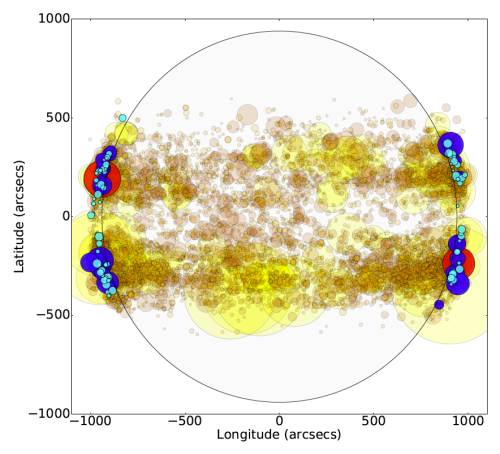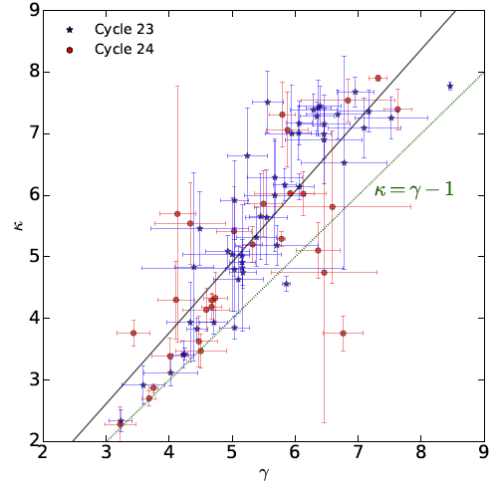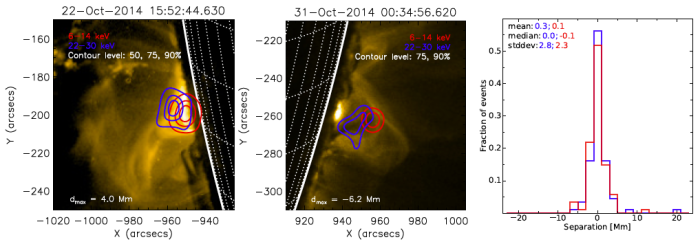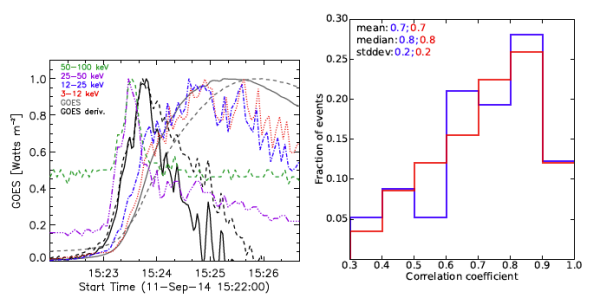Hard X-ray Emission from Partially Occulted Solar Flares
| Nugget | |
|---|---|
| Number: | 291 |
| 1st Author: | Frederic Effenberger |
| 2nd Author: | Fatima Rubio da Costa |
| Published: | 30 January 2017 |
| Next Nugget: | RHESSI's 15th Anniversary |
| Previous Nugget: | GOES Hard X-rays? |
Introduction
Hard X-ray emission of solar flares can enable insights into the non-thermal energetic particle properties created during these eruptive events. Depending on the coronal densities and plasma properties, a part of the non-thermal electron population can be trapped in coronal magnetic fields. Theory suggests that the coronal region at the top of magnetic loops may be the main acceleration site for electrons. At high energies, however, the bright footpoint emission from these flare loops can obscure weaker loop-top sources due to the limited dynamic range of instruments like RHESSI. Thus, flares close to the solar limb, where the footpoints are occulted, are interesting events to study because they can reveal the emission in this region in isolation. This method has revealed many things. Here, we report on recent findings of a statistical study of occulted events, comprising of about 120 flares during solar cycles 23 and 24 (Ref. [1]).
It is interesting to also study the so-called Neupert effect (Ref. [2]) in this context of coronal sources. The Neupert effect is an empirical correlation in solar flares, which relates the changes (i.e. the time derivative) in the soft X-ray (SXR) flux to the temporal hard X-ray (HXR) variations. These HXRs tend strongly to originate in the footpoint regions, leading to the "thick target" interpretation of coronally accelerated electron beams hitting the transition region and chromosphere. This in turn can lead to heating processes, increasing the overall SXR and extreme ultraviolet (EUV) emission, as observed by the GOES photometers.

Occulted Flare Selection and Results
An earlier analysis studied 55 partially occulted flares from solar cycle 23 (Ref. [3]). We have now extended this list to Cycle 24 with selection criteria based on flares from the RHESSI flare catalog, requiring significant counts at energies of 25 keV and occulted footpoints as indicated by having the centroid position above the solar limb. We studied 61 flares from solar cycle 24 in addition to the 55 from cycle 23. Figure 1 shows their distribution on the solar disk.
Using GOES, SDO/AIA, and RHESSI we performed a spectral analysis, a light curve correlation between different wavelength ranges, and X-ray imaging to study the spatial relation between soft and hard X-rays.
Spectral Analysis
We performed two kinds of spectral analysis: a thermal spectrum (see CHIANTI) plus the usual ad hoc broken power-law model to describe the accelerated electrons, and a thermal spectrum plus a kappa-distribution spectral model for the accelerated electrons.
Figure 2 shows the resulting spectral index κ versus the photon index γ. The mean values are <γ> 5.7, similar to the previously reported value of 5.4, and <κ> = 5.4. These are softer than what is found for the high-energy index of disk flares, which contain the footpoint emission with harder spectrum.

The relation between the electron flux spectral index δ and the electron kappa distribution index is δ = κ. In the thin-target case, we expect δ = 1.15κ - 0.83 (the green dotted line in Figure 2). A linear-least-square fit to the fitting parameters gives δ = 0.83κ -1.15 (black dashed line).
Spatial separation of thermal and non-thermal emission
Images in a low 6-14 keV and high-energy (>20 keV) range allow us to estimate the radial separation between the thermal and non-thermal emission, by measuring the distance dmax between the maximum of both sources (see Figure 3).

Although we did not find a clear tendency toward positive or negative separations between both sources,<dmax> = 0.3 Mm, which may imply that higher-energy emission is radially farther out in the corona.
Light-curves and the Neupert effect
We analyzed the time evolution of the hard X-ray flux measured by RHESSI and compared it with the temporal derivative of the soft X-ray flux measured by GOES at 0.5-4 Å. We calculated the linear correlation between soft and hard X-rays.

In Figure 4 we find that the 25-50 keV RHESSI energy channel correlates well with the GOES time derivative during the rise phase, with a small temporal lag. The statistical results for the correlation coefficient are significant for a large fraction of flares in the sample.
Conclusions
The three parts of the study of occulted flares allow us to conclude
• Spectra of occulted flares tend to be softer than general disk flares with the relation between the photon and electron indexes in rough agreement with that expected in a thin-target model;
• There is no clear trend for large positive or negative radial separations between low and high energy hard X-ray components. There are, however, notable exceptions with larger separations and a richer coronal source structure;
• There is a significant correlation between the time derivative of the soft X-ray and the observed hard X-rays light curves for a large fraction of our sample, consistent with earlier studies for on-disk flares (Ref. [5]).
This latter conclusions indicates the presence of the simple Neupert effect for purely coronal sources and supports the scenario that the main source of non-thermal particles is produced near the looptop. The lags found in some flares indicate that additional processes like thermal conduction can play important roles.
References
[1] "Hard X-Ray Emission from Partially Occulted Solar Flares: RHESSI Observations in Two Solar Cycles"
[2] "Comparison of Solar X-Ray Line Emission with Microwave Emission during Flares"
[3] "Hard X-ray emission from the solar corona"
[4] "Kappa distribution and hard X-ray emission of solar flares"